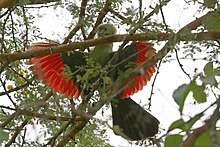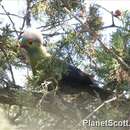Biology
provided by Arkive
This arboreal bird mainly feeds on fruits, with figs (Ficus), Juniperus procera and Podocarpus gracilior being the main food plants (2) (4).
No definitive information is available on the reproductive biology of Prince Ruspoli's turaco, but there are local reports that it breeds from December to February in Sidamo Province, which requires investigation (2). Hybrids between this species and the white-cheeked turaco (T. leucotis)have been observed, most commonly in edge habitats (4).
Conservation
provided by Arkive
Prince Ruspoli's turaco and its habitat receive some degree of protection in the woodlands of Anferara-Wadera and adjacent Bore-Anferara, which have been designated as National Forest Priority Areas. These areas are now thought to hold the majority of the species' population, and it has been advocated that protecting other key sites could greatly benefit this distinctive Ethiopian bird (4).
Description
provided by Arkive
With its colourful plumage and distinctive, erect white crest, this long-tailed, arboreal bird forms an impressive sight in the woodlands of southern Ethiopian (4). The prominent greyish-white crest shades to rose-pink at its base, complimenting the crimson colour of the bill, wattle above the eye, nape of the neck, and wing patch (2) (4). The head, neck, breast and upper back are moss-green, greyish green on the chin and throat and a more vivid yellowish green on the cheeks and ear-coverts, while the lower back, wings and tail are a darker, greyish-blue and the belly and thighs are blackish (2).
Habitat
provided by Arkive
Although found in juniper (Juniperus) woodland with dense evergreen undergrowth near Arero and Wadera, Prince Ruspoli's turaco is thought to favour drier forest margins, acacia-conifer woodland and mixed broadleaf scrub, from 1250 to 1860 m above sea level (2).
Range
provided by Arkive
Restricted to a narrow range in southern Ethiopia, around Arero, Bobela, Sokora, Negele and Wadera (2) (4).
Status
provided by Arkive
Classified as Vulnerable (VU) on the IUCN Red List 2006 (1) and listed on Appendix II of CITES (3).
Threats
provided by Arkive
Although Prince Ruspoli's turaco is thought to be undergoing a continuing decline as a result of loss, degradation and fragmentation of its woodland habitat and hybridisation with T. leucotis, recent surveys have revealed that it is in fact more common and widespread than once believed (2) (4). Agricultural expansion, overgrazing, uncontrolled bushfires and firewood collection are the main causes of habitat destruction, but this bird does seem to be able to tolerate some human exploitation of its habitat. Plantations of exotic tree species (Eucalyptus spp, Cupressus spp) have also expanded in recent years, which, together with habitat degradation, have helped facilitate the expansion of the forest-preferring white-cheeked turaco (T. leucotis) into the range of the more woodland-inhabiting Prince Ruspoli's turaco. While Prince Ruspoli's turaco does not appear to be suffering from competition with the white-cheeked turaco, hybridisation is affecting the species by diluting its genetic integrity and reducing the number of pure-bred individuals remaining (4).
Ruspoli's turaco
provided by wikipedia EN
Ruspoli's turaco (Menelikornis ruspolii), also known as Prince Ruspoli's turaco, is a species of bird in the family Musophagidae. It is endemic to southern Ethiopia where its natural habitat is subtropical or tropical dry forests. It is threatened by habitat loss.
Taxonomy

Ruspoli's turaco photographed in the Negele Borena region in Ethiopia

Ruspoli's turaco photographed in the Negele Borena region in Ethiopia
The species was first collected by Eugenio Ruspoli in either 1892 or 1893, but due to his subsequent death, the location and date of this find remain unknown. However, his collection was examined by T. Salvadori, who named the bird in his honor.[2]
References

- license
- cc-by-sa-3.0
- copyright
- Wikipedia authors and editors
Ruspoli's turaco: Brief Summary
provided by wikipedia EN
Ruspoli's turaco (Menelikornis ruspolii), also known as Prince Ruspoli's turaco, is a species of bird in the family Musophagidae. It is endemic to southern Ethiopia where its natural habitat is subtropical or tropical dry forests. It is threatened by habitat loss.
- license
- cc-by-sa-3.0
- copyright
- Wikipedia authors and editors

